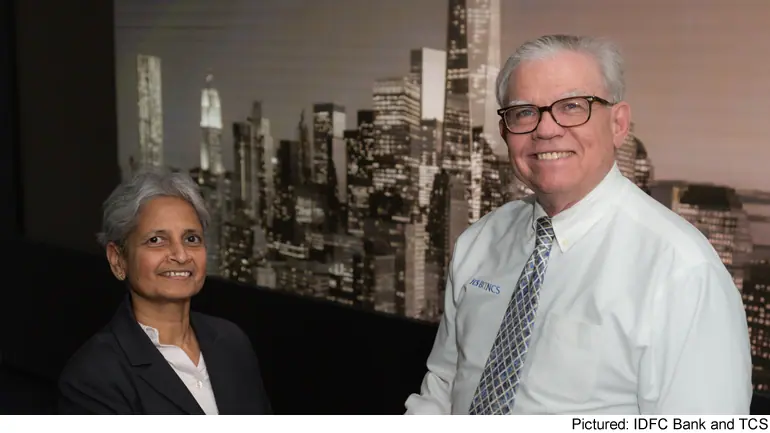
Bringing Finance to the Unbanked in India
With about 40 percent of its entire population currently unbanked, India represents a unique challenge for banks and financial institutions looking to expand their services to the country’s consumers. Moreover, around 70 percent of the roughly 1.3 billion people in India live in rural areas, many of which lack reliable infrastructure and are difficult to access by road.
Add those factors to the Indian government’s recent demonetization program to take physical money out of circulation in favor of digital banking and payments and you have a tough environment for banks when it comes to signing up new customers.
That’s precisely what the Infrastructure Development Finance Company (IDFC) Bank, a newly formed commercial and consumer bank based in Mumbai, was faced with in 2015. IDFC has been in existence since 1997, but solely as a lending institution for infrastructure projects. As IDFC grew, the bank decided it was time to tackle the more traditional consumer and business markets for financial services.
But in order to obtain (and maintain) a license to operate in the consumer sector, the Reserve Bank of India (RBI) mandated that IDFC expand into rural areas and commit to serving the unbanked in those communities. In addition, the RBI gave IDFC a deadline of only 18 months to be operational in rural communities. Failure would result in the cancellation of IDFC’s license to operate in the consumer market.
IDFC needed a technology partner that had both a track record of success, as well as the capability, commitment and innovation to help solve the problem of reaching the unbanked. IDFC ended up partnering with Indian multinational IT company Tata Consultancy Services (TCS). Tata Consultancy works with organizations across the world to effectively integrate technology to achieve their business goals, and in 2015 was ranked the 64th most innovative company in the world by Forbes, making it the highest-ranked IT services company—as well as the top Indian company.
What Tata did for IDFC was develop a system called the TCS BaNCS core banking solution, designed to transform the bank from a vehicle for infrastructure financing into a full-service institution catering to a broad spectrum of customers, from wealthy corporate clients to the rural unbanked. Tata had already rolled out similar projects worldwide over 300 times, for some of the world’s largest banks. BaNCS is an all-encompassing enterprise banking system, supporting the premise that customers should have a seamless, convenient banking experience from any device, anywhere. This is especially critical for serving the unbanked, as smartphones are often their only access to basic financial services.
Specifically, Tata developed a “Bank-in-a-Box” scheme along with BaNCS, creating a portable device that performs many of the basic functions a physical bank can. Tata refers to the actual technology as a Micro ATM, authenticating each user with cutting edge fingerprint and biometric authentication. These Micro ATMs, along with BaNCS smartphone integration, allowed IDFC to meet the goals set forth by RBI in terms of serving the unbanked market in India.
Customers can open and activate a new account at a Micro ATM in around four minutes, using a combination of biometrics and common identifiers like a mobile number. Micro ATMs have also proven to be cost-effective, with devices costing less than $295. Within nine months of TCS BaNCS implementation, more than one million rural IDFC customers have benefitted from Micro ATMs to do things like transferring cash and paying utility bills. More than 1,000 IDFC Micro ATMs were launched within a year, also resulting in employment opportunities for rural Indians since the Micro ATMs do require an on-site customer service liaison. Today, there are around 6,500 agents, growing at a rate of about 300 daily.
Aside from offering the rural unbanked in India a customer experience head-and-shoulders above what previously existed, IDFC saw its profitability increase six times over the first year of TCS BaNCS, going from US$8.53 million to US$56.91 million in net profits. Tata also had BaNCS operational in only nine months, despite having to link together and integrate 18 disparate systems within IDFC.
Importantly, access to financial services for the underbanked in rural India were also expanded by more than 50 percent for those areas (like the Krishna district of Andhra Pradesh province) serviced by Micro ATMs. The underbanked includes the self-employed, micro-enterprises and marginal farmers, who are now more financially empowered thanks to the partnership between IDFC and Tata.
Today, IDFC’s Micro ATMs are available in 16 states across India, with the underbanked now able to access government welfare benefits and remit payments to relatives in other remote areas. The TCS BaNCS partnership shows that—with an innovative approach and the use of technology—banks can both generate substantial benefits for both themselves and for rural developing communities.
This is one of 10 case studies that focus on examples of successful innovation between banks and financial technology companies working in partnership. The participants featured in this article were finalists at the 2017 Best of FinXTech Awards.


